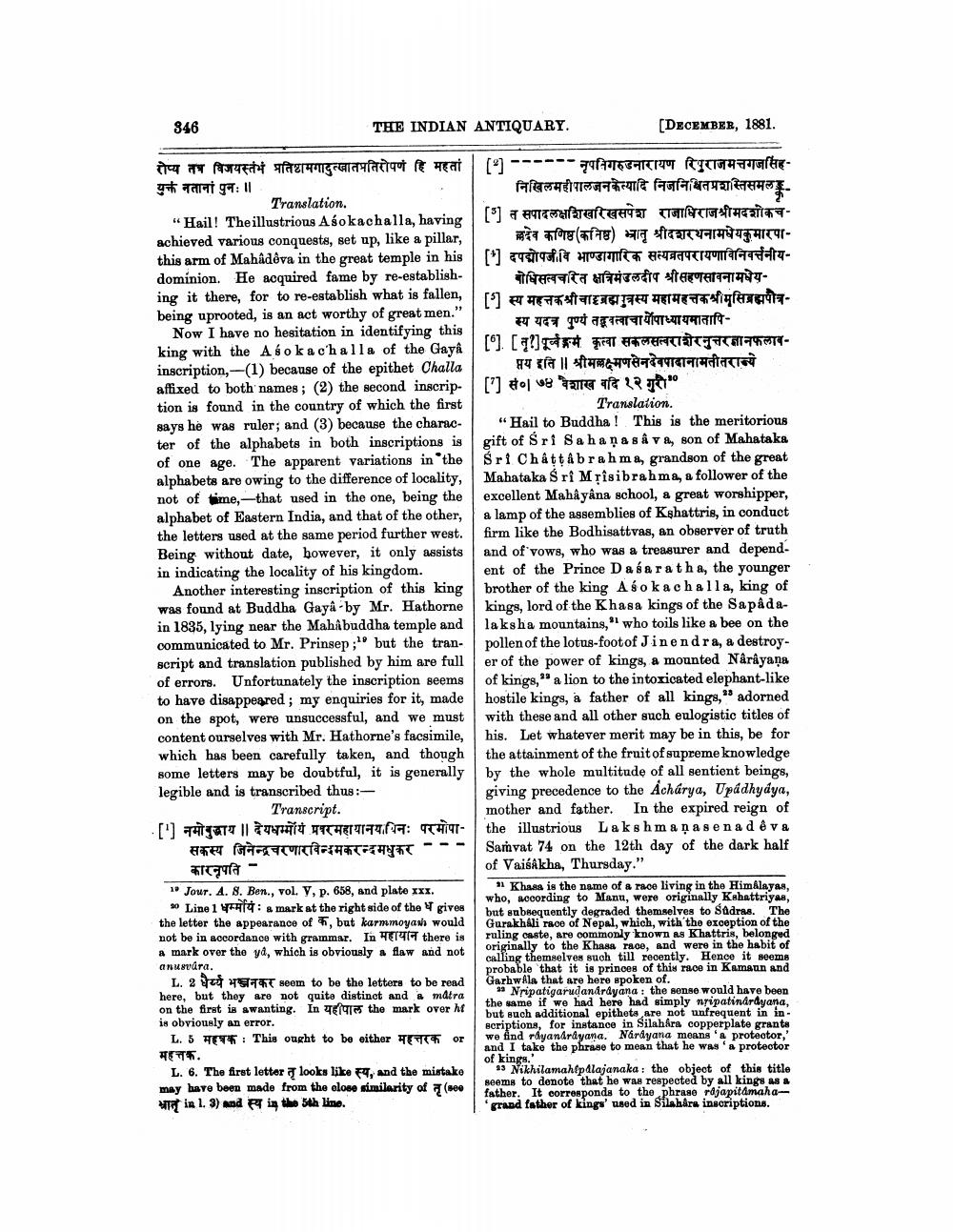________________
346
THE INDIAN ANTIQUARY.
[DECEMBER, 1881.
AUTY TF fang adiqot heat ] ----- Ear Taraftary TGITT FT: 11
| निखिलमहीपालजनकेत्यादि निजनिश्चितप्रशस्तिसमला. Translation. "Hail! The illustrious Asokachalla, having
| [७] त सपादलक्षशिखरिखसपेश राजाधिराजश्रीमदशोकचachieved various conquests, set up, like a pillar,
देव कणिष्ठ (कनिष्ठ) भातृ श्रीदशरथनामधेयकुमारपाthis arm of Mahadeva in the great temple in his | [१] दपद्मोपजीवि भाण्डागारिक सत्यव्रतपरायणाविनिवर्त्तनीयdominion. He acquired fame by re-establish- बोधिसत्वचरित क्षत्रिमंडलदीप श्रीसहणसावनामधेयing it there, for to re-establish what is fallen,
| [३] स्य महत्तकश्रीचाहब्रह्मपुत्रस्य महामहत्तकश्रीमसिब्रह्मपौत्रbeing uprooted, is an act worthy of great men."
स्य यदत्र पुण्यं तद्वत्वाचार्योपाध्यायमातापिNow I have no hesitation in identifying this king with the Asoka c'halla of the Gayê
[9] [!] | TAHTITECHhT4inscription,-(1) because of the epithet Challa तय इति || श्रीमलक्ष्मणसेनदेवपादानामतीतराज्ये affixed to both names; (2) the second inscrip- [') #1 1814 af 1 0 tion is found in the country of which the first
Translation. says he was ruler; and (3) because the charac- "Hail to Buddha ! This is the meritorious ter of the alphabets in both inscriptions is gift of Sri Sahaņas â , son of Mahataka of one age. The apparent variations in the Sri Châttâbrahma, grandson of the great alphabets are owing to the difference of locality, Mahataka Sri Mrisibrahma, a follower of the not of hime,--that used in the one, being the excellent Mahayana school, a great worshipper, alphabet of Eastern India, and that of the other, a lamp of the assemblies of Kshattris, in conduct the letters used at the same period further west. firm like the Bodhisattvas, an observer of truth Being without date, however, it only assists and of vows, who was a treasurer and depend in indicating the locality of his kingdom. ent of the Prince Dasaratha, the younger
Another interesting inscription of this king brother of the king Aso kachalla, king of was found at Buddha Gaya - by Mr. Hathorne kings, lord of the Khasa kings of the Sapadain 1835, lying near the Mahabuddha temple and laksha mountains," who toils like a bee on the communicated to Mr. Prinsep ;- but the tran- pollen of the lotus-foot of Jinendra, a destroyscript and translation published by him are full er of the power of kings, a mounted Narayana of errors. Unfortunately the inscription seems of kings," a lion to the intoxicated elephant-like to have disappeared ; my enquiries for it, made hostile kings, a father of all kings," adorned on the spot, were unsuccessful, and we must with these and all other such eulogistic titles of content ourselves with Mr. Hathorne's facsimile, his. Let whatever merit may be in this, be for which has been carefully taken, and though the attainment of the fruit of supreme knowledge some letters may be doubtful, it is generally by the whole multitude of all sentient beings, legible and is transcribed thus :
giving precedence to the Acharya, Upadhyaya, Transcript.
mother and father. In the expired reign of .[1] नमोबुद्धाय ।। देयधोय प्रवरमहायानयापिनः परमोपा- the illustrious Lakshmanasenad dva
सकस्य जिनेन्द्रचरणारविन्दमकरन्दमधुकर --- Sarvat 74 on the 12th day of the dark half Argyra
of Vaisakha, Thursday." *Jour. 4. 8. Ben., vol. V, p. 658, and plate III.
Khana is the name of a race living in the Himalayas, * Line 1 Yht: a mark at the right side of the gives
who, according to Manu, were originally Kshattriyas,
but subrequently degraded themselves to Sadra. The the letter the appearance of , but karnmoyans would Gurakh Ali race of Nepal, which, with the exception of the not be in accordance with grammar. In HERTT there is ruling caste, are commonly known as Khattris, belonged a mark over the yd, which is obviously flaw and not
originally to the Khasa race, and were in the habit of anusvára.
calling themselves such till recently. Hence it nooma
probable that it is princes of this race in Kamaun and L.2 धैर्य भवनकर seem to be the letters to be read Garhwala that are here spoken of. here, but they are not quite distinct and matra
# Nripatigarudandrdyana: the sense would have been on the first is awanting. In Tee the mark over hi
the same if we had here had simply nipatinardyana, is obviously an error.
but such additional epithets are not unfrequent in in
scriptions, for instance in Silahára copperplate granta L. महत्रक: Thia ought to be either महत्तरक or we find rdyandrdyana. Nardyana means ' protector, HET.
and I take the phrase to mean that he was a protector
of kings. L. 6. The first letter looks like F, and the mistake 13 Nikhilamahfpdlajanaka : the object of this title may have been made from the close similarity of (see
seems to denote that he was respected by all kings as a
father. It corresponds to the phrase rajapitamahaWTO in l. 3) and in the 5th line.
grand father of kings' used in Silahåra inscriptions.




